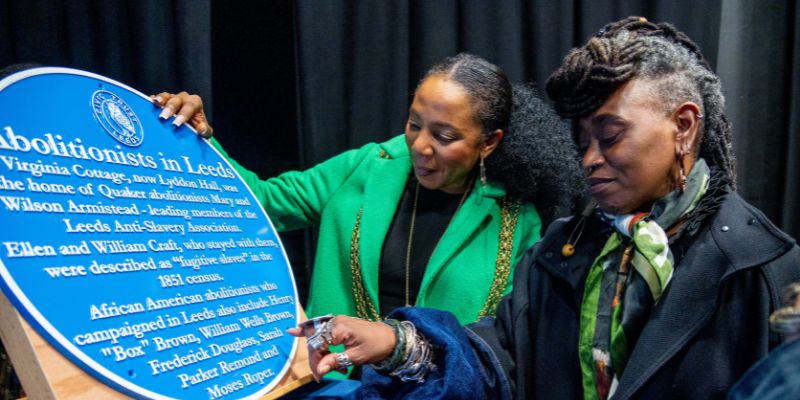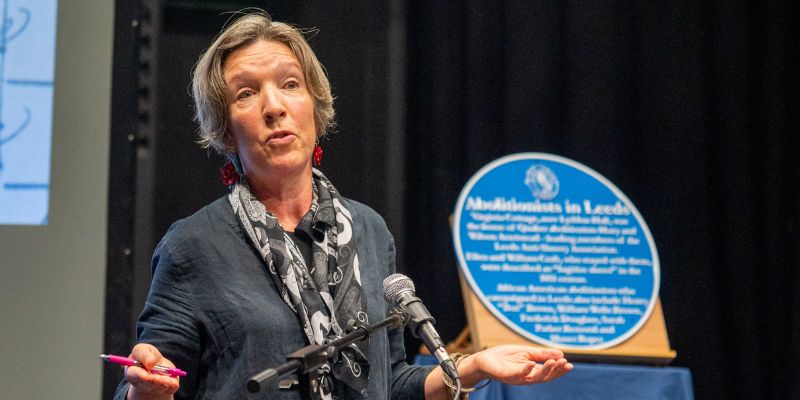
Campaigners who were at the forefront of the global movement to abolish slavery, including Wilson Armistead, are being honoured at the University of Leeds.
Leeds’ history as a vital location of anti-slavery campaigning has been highlighted with the unveiling of a blue plaque for the University’s Lyddon Hall, at the start of Black History Month.
Leeds should be better-known for its connection to the history of abolition and anti-slavery in the United States.
Now a student residence, Lyddon Hall was the home of Mary and Wilson Armistead for several years. Wilson was a Quaker merchant and president of the Leeds Anti-Slavery Association. His wife Mary was the association’s librarian.
The Leeds Anti-Slavery Association was founded in 1853, admitting men and women as equal members. They learned from the inspirational lectures of African American abolitionists who visited the city, including William Wells Brown, Henry "Box" Brown, Ellen and William Craft, Frederick Douglass, Sarah Parker Remond and Moses Roper – who are named on the new plaque.
Lyddon Hall was built in 1828 by the Boyne family and was originally named Virginia Cottage after the state where the tobacco that made their fortune was grown. Their wealth derived from the labour of enslaved people of African descent, who had no legal rights and were forced to work under appalling conditions.
But just decades later in the 1860s the Armisteads, who were by that time living in the house, used it as a centre to collect goods and funds for newly emancipated people in the United States.

Professor Bridget Bennett (pictured) from the University’s School of English, whose research was instrumental in the campaign for the plaque, said: “Leeds should be better-known for its connection to the history of abolition and anti-slavery in the United States. The campaign for this plaque has been ongoing for many years, with the input of different people across the city. It’s an important example of how universities can work together with local organisations and communities to have real impact.”
Despite pre-dating the University’s inception as the Yorkshire College of Science in 1874, the Armisteads have several connections to the campus. Works by Wilson, including records from the Yorkshire Quaker Archives, are held in the University Library’s Special Collections.
‘Fugitive slaves’ and their great escapes

Ellen (left) and William (right) Craft. Credit: New York Public Library Digital Collections.
The plaque, commissioned by Leeds Civic Trust, commemorates the amazing story of Ellen and William Craft, who travelled north through the United States from Georgia to Boston to emancipate themselves from enslavement.
Ellen cut her hair short and wore men’s clothes to disguise herself as a rich white man travelling with William, who posed as a personal servant. She also wore a sling to hide the fact that she couldn’t write, behaving as though she was disabled.
The Fugitive Slave Act of 1850 made it legal for emancipated slaves to be pursued by bounty hunters in the US, even in free states. Many fugitives left for Canada or Britain to escape recapture, and the Crafts fled to Liverpool on a steamboat as a result. Once they arrived, they continued their abolitionist work, lecturing in cities and towns.
The Crafts stayed with the Armisteads at another Leeds residence when they were lecturing in the city, where Wilson Armistead recorded their names in the 1851 UK census, referring to them each as a ‘fugitive slave’ as a protest against the repressive American law. This unprecedented action was covered widely in the press.
Professor Bennett explored the significance of the census inscription in recent research funded by the Leverhulme Trust, and her upcoming book, ‘Antislavery in the Dissenting Atlantic’ (Louisiana State University Press) explores the story behind Leeds as a hub for abolitionism.
Henry “Box” Brown, whose name is also included on the plaque, was another key African American abolitionist, who emancipated himself from enslavement in Virginia by concealing himself in a box which was posted to Philadelphia. In 1851, he re-enacted his journey in the UK, traveling in a box by rail from Bradford to Leeds as part of anti-slavery campaigning.
Professor Bennett added: “Leeds is known as a clothworking city, which had a thriving industry producing woolen and linen cloth. But just across the Pennines, Manchester’s economy was indebted to cotton, chiefly sourced from the plantations in the slave states in the US that relied on unfree labour.
“In both northern cities, regular people were actively campaigning against slavery. After the Slavery Abolition Act of 1833 abolished slavery in British colonies, abolitionists in Leeds and Yorkshire played a key role in the campaign to end slavery across the United States.”
Leeds Civic Trust director, Martin Hamilton, said: “The abolitionist heritage of our city deserves to be better-known and we hope that this plaque will help to set the record straight.”
The power of collaboration

Caption: (left to right) Professor Richard Blackett, Professor Bridget Bennett, Dr Kendi Guantai, Martin Hamilton and Councillor and Lord Mayor of Leeds Abigail Marshall Katung
Dr Kendi Guantai, Dean for Equity, Diversity and Inclusion at the University of Leeds, said: “Collaboration is one of our four university values, and this project is a perfect example of what's possible when university colleagues and stakeholders pull together for a common cause. I am delighted at the enthusiasm with which this work has been received and draw inspiration from knowing that it is not happening in isolation.
“Later in October, colleagues from our university community will be coming together to participate in an Editathon – hosted by our libraries and Wikimedia UK – dedicated to developing Wikipedia pages on the anti-slavery and abolitionist movements in Leeds. I look forward to working with all involved to grow this body of work. Many congratulations to Bridget and the team for this remarkable achievement.”
This is a shared triumph for research and the local community, and is a fantastic example of the power of collaboration.
Professor Hai-Sui Yu, Interim Vice-Chancellor and President of the University of Leeds, said: “Arts and humanities research is sometimes undervalued, but this blue plaque shows the significance such research has in uncovering stories which help us understand the city’s past – and present. This is a shared triumph for research and the local community, and is a fantastic example of the power of collaboration.”
The blue plaque was unveiled by Councillor Abigail Marshall Katung, Lord Mayor of Leeds and alum of the University, at an event on Tuesday. The event included a Black History Walk with a visit to Lyddon Hall, and a lecture by Professor Richard Blackett from Vanderbilt University, a leading historian of the abolitionist movement in the US.
Further information
Top image caption: Councillor Abigail Marshall Katung, Lord Mayor of Leeds, and poet Khadijah Ibrahim view the plaque. Photos by Mark Bickerdike.
The wording on the blue plaque reads: Virginia Cottage, now Lyddon Hall, was the home of Quaker abolitionists Mary and Wilson Armistead – leading members of the Leeds Anti-Slavery Association. Ellen and William Craft, who stayed with them, were described as “fugitive slaves” in the 1851 census. African American abolitionists who campaigned in Leeds also include Henry “Box” Brown, William Wells Brown, Frederick Douglass, Sarah Parker Remond and Moses Roper.
For more information, please contact Mia Saunders in the University of Leeds press office on m.saunders@leeds.ac.uk.